

SANTA FE
THE CITY DIFFERENT
CYCLOCROSS
THE MOST FUN YOU’LL HAVE ON TWO WHEELS BEE-FOCUSED IN THE YUCATÁN



THE CITY DIFFERENT
THE MOST FUN YOU’LL HAVE ON TWO WHEELS BEE-FOCUSED IN THE YUCATÁN

















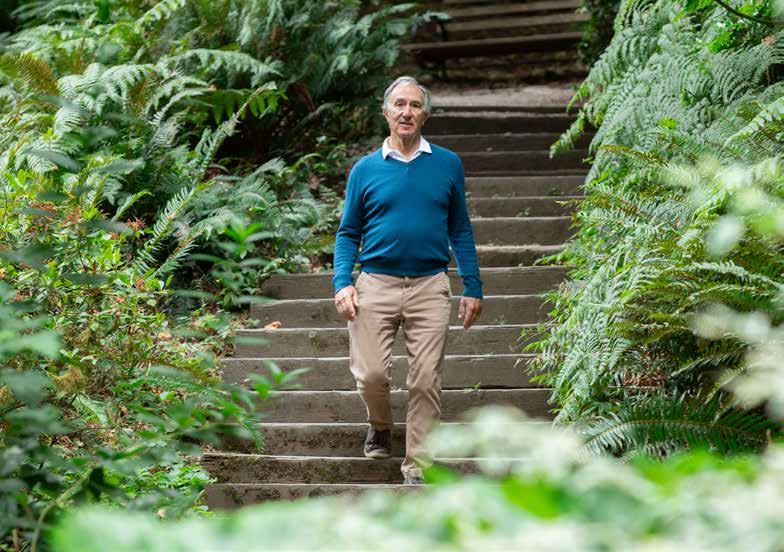







See trendsetting looks on the runway with 100% of ticket sales benefitting local nonprofits. Go beyond the shows with beauty and fitness events, plus irresistible shopping.



For tickets and event details: fashionweekbellevue.com








There’s a certain magic to fall in the Pacific Northwest and if I’m honest, it might be my favorite season. Not because I’m excited for the return of pumpkin spice lattes and scented candles—don’t mind me, I’m a bit of a curmudgeon—no, for me, it’s all about the food. The markets overflow with the season’s bounty: squash, apples, freshly foraged wild mushrooms and root vegetables still dusted with dirt. Cooler, rainy weather means the pace slows and the menu calls for heartier flavors, longer braises and the kind of comforting dishes that gather people around a table.
This issue, I wanted to share a recipe that captures everything I love about autumn: rich, flavorful ingredients layered with warmth and depth. Whether you prepare it for a cozy family dinner or to impress guests, I hope it brings the same joy to your home that it brings to mine.
Warmly,
Danny Gilmore, Executive Chef
• 10 lbs. beef short ribs
• salt and pepper to taste
• ¼ cup canola oil
• 4 carrots, chopped
• 2 onions, chopped
• 1 celery stalk, chopped
• 3-4 cloves garlic, minced
• 2 cups tomato paste
• 2 cups red wine
• 2 Tbsp thyme, finely chopped
• 3-4 bay leaves
• 28-oz. can crushed tomatoes
• 16 cups beef stock
DIRECTIONS
• Preheat oven to 275°F
• Season short ribs with salt and pepper
• Add oil to a large pan over high heat
• Sear the ribs on all sides, working in batches if necessary
• Transfer ribs to a deep oven-safe pan or dish
• Lower heat to medium and add carrot, onion and celery to the same pan
• When the vegetables begin to soften, add garlic
• Sauté until the garlic becomes fragrant
• Add tomato paste and stir for a minute or two
• Add the red wine, scraping up the browned bits from the bottom of the pan—lots of good flavor there
• Add in thyme and bay leaves
• Add crushed tomatoes and beef stock; bring to a boil
• Pour the hot mixture over the short ribs, cover with a lid or aluminum foil and braise for around 4 hours or until tender
Serve with creamy mashed potatoes, sauteed green beans and a loaf of crusty bread from your local bakery.
Serves 4 to 6 people.
CLUB
(ISSN 1096-8105) is
bi-monthly by the Bellevue Club, 11200 S.E. 6th, Bellevue, WA 98004. Copyright 2019 by Bellevue Club. All rights reserved. Reproduction in whole or in part without express written permission is prohibited. Publication number 715390. Periodicals postage paid @ Bellevue, WA, and additional offices. Editorial, Advertising and Circulation Office: P.O. Box 90020, Bellevue, WA 98009 (mailing address); 11200 S.E. 6th, Bellevue, WA 98004 (street address); telephone 425.455.1616. Produced by Vernon Publications, LLC, P.O. Box 970, Woodinville, WA 98072-0970. POSTMASTER send address changes to BELLEVUE CLUB REFLECTIONS, 11200 S.E. Sixth St., Bellevue, WA 98004.





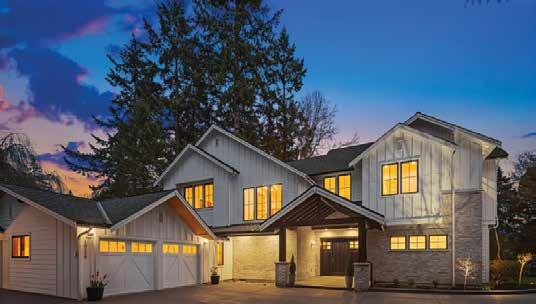

HALLOWEEN CARNIVAL OCT 24 | 5:30-8 PM
Calling all ghouls and goblins! It's time for our annual Halloween Carnival. Join us in the Gym for games, crafts, bouncy houses and more. $30/kids ages 1-16 | kids under 1 and adults are free.
LABOR DAY 2-7 BACK TO SCHOOL SALE IN ECLIPSE
MINGO MANIAC: MUSIC, BINGO & FUN 6-8 PM 4-5 LADIES CUP BOOT CAMPS | 9:15 AM-2:15 PM
PILATES STUDIO INTRO SERIES FOR SENIORS | 11:30 AM-12:20 PM
CLEAR THE KEG | 11 AM-9 PM
LADIES CUP PROGRAM BEGINS
WINE TASTING WITH EVERGREEN FAMILY WINES | 4-5:30 PM
PILATES FOUNDATION SERIES | 10-10:55 AM
MEN’S TEAM TENNIS FALL SESSION BEGINS 10, 17, 24 WHISKEY WEDNESDAY | 10-10:55 AM 12 PRINCESS BALL |
Atrium | Fridays | 5:30-8:30 PM 9/5, 9/12, 9/26 10/3, 10/10, 10/24 SPLASH INTO
Splash | Mondays | 5:30-7:30 PM Except Labor Day, Sep 1
AQUATICS EVENTS
Inflatable Obstacle Course Saturdays | 6-7:30 PM Water Runner Sundays | 5-6:30 PM



Every year, our frightfully festive crew of ghouls and grinning goblins transforms the basketball gym into a Halloween playground bursting with eerie enchantment and spook-tacular decor—perfect for scaring up a screamworthy good time.
From bobbing for doughnuts (no hands, allowed!) to bounce house madness and a spirited bar for grown-up ghosts, there’s a monstrous mix of fun for every age. Expect classic
carnival games, frighteningly fun facepainting and balloon-twisting wizards conjuring up spooky shapes.
Summon your little monsters (and yourself!) in your most fang-tastic costumes, then creep into the photo booth to capture a memento of this boo-rilliant bash.
$30/ kids ages 1 to 16 | kids under 1 and adults are free.
FAMILY PUMPKIN CARVING Monday, October 20 | 5–7 PM
Leave the mess with us while you and your family focus on carving the best pumpkin in town. We’ll provide everything you need, from a big bowl for the pulp and seeds to the proper carving tools to get the job done safely. $30/pumpkin






There’s a new hot spot for kiddos opening in Issaquah this fall.
Leave it to lifelong Pacific Northwesterners Graham and April Quinn to provide a solution for one of our biggest dilemmas as parents: What do I do with my children when the weather is gross?
Their answer: The Sand Garden, an indoor sandbox experience designed for calm, creative play.
When April, an elementary school teacher, became a stay-at-home mom, she realized the lack of indoor play spaces—especially those that don’t also have flashing lights and loud music. So she, and her husband Graham, decided to rectify the situation, much to the delight of caregivers far and wide.
“We wanted to create a calming environment—soft, natural colors and a cozy vibe—something that’s relaxing and enjoyable for both parents and kids,” she explains. “The Sand Garden will have a unique aesthetic: garden-themed, floral accents, wooden toys.”
While April will be front of house, managing events and the customer experience, Graham, whose family members have belonged to the Club for decades, is leveraging his background in tech to manage operations and the business side.
Expect 1,400 total square feet of play areas—one for infants and one for older kids up to 10—filled with special low-dust, silica-free sand from a quarry in Quebec. Kids will have their choice of classic sandbox toys, including shovels, pails and construction machines. There will also be a wooden bridge, a slide and a farmers’ market stand for pretend play.
Seating will be plentiful, with some benches inside the sandbox for parents who want to stay within arm’s reach. There will be a designated eating area with simple snacks for kids and coffee for grown-ups—no food or beverages allowed in the sandbox.
The space has a party room—named Bo’s Shed after their 8-year-old golden retriever—and April is excited to add sensory classes and parent-child experiences to the calendar.
Cleanliness is of paramount importance, so shoes, socks or toys from home are not permitted in the play areas. And several procedures are in place to clean and maintain the sand for safe enjoyment.
The Sand Garden opens this fall at 660 NW Gilman Blvd C2, Issaquah. Hours are 9 a.m. to 5 p.m., seven days a week, excluding holidays and special closures.
thesandgardenllc.com
Whether you’re navigating complex regulatory landscapes, optimizing strategic investments, or forecasting outcomes with precision, our team brings:
– Artificial Intelligence Era Law & Economics
– Litigation
– Legacy Innovation
– Cultural Innovation
– Cognitive Artificial Intelligence



Proper form is key to exercising safely. But as we become more comfortable with our routines, our discipline slips and we may find ourselves slouching when we should be straight, bending from the wrong place or forgetting the most important thing: to breathe.

Bellevue Club Personal Trainer Cassidy Schukar offers up the following three reminders to keep your workout basics on the right track:
1.Maintain a neutral spine and straight back.
Remember to keep your chest up, your shoulder blades pulled back and down, and your core engaged. Don’t arch your back excessively. Pull your ribs in and down to brace your core.
2.Be mindful when reracking weights.
To be safe, keep the weights close to you, engage your core and bend from your knees and legs, rather than your back, which should be kept straight. This will protect your lower back from bearing the brunt of the load.
3.Keep your core engaged . . . and breathe.
It’s very common for clients to hold their breath when they brace their core and you’ll often hear personal trainers reminding them to keep breathing. There are many reasons for this, including avoiding a potentially dangerous increase of pressure in the abdomen and maintaining stability to avoid injury. Additionally, holding your breath during core engagement can lead to more fatigue and a less effective workout.

MEET THE TRAINER
Cassidy’s love for fitness began with her own journey to improve her health and lifestyle when she discovered strength training after high school and became passionate about holistic wellness. She has a degree in nutrition and exercise science from Bastyr as well as a Personal Training certification from the American College of Sports Medicine. She specializes in weight management, strength and functional training, and health and wellness.































Physical Therapist Dr. JJ Murphy,
Personal Trainer Jerry Flynn and Golf
Pro John Kim explain how a holistic approach to offseason training is the key to your perfect swing
Here’s a little secret , something that golf pros and serious amateurs already know: the best possible game comes from developing a team of experts trained by the Titleist Performance Institute (TPI) who can support every aspect of your swing—from biomechanics and injury prevention to performance optimization.
Fortunately for you golfers out there, Bellevue Club already has that team assembled and ready.
Launched in 2003 by the makers of the Titleist golf ball, TPI trains physical therapists, personal trainers and golf pros to maximize each individual’s swing—not replicate someone else’s.

“Personal trainers take clients through basic movement screens looking at mobility, stability and strength but refer out if a client is experiencing pain,” explains Jerry Flynn , a personal trainer at the Club who has been TPI-certified since 2017.
“My role as a trainer is to prepare a client’s body to improve performance when possible and reduce the chance of injuries,” he says. “Age, health, injury history and golf experience all help determine the design of a golf-specific fitness program.”
POV: Physical Therapy

“TPI focuses on the kinematic sequencing of everyone’s golf swing,” explains Dr. JJ Murphy, a physical therapist who started seeing patients at the Club in July. “Their philosophy is that each golfer has their own capabilities and abilities to perform a golf swing, meaning there is no ‘right way’ to swing a golf club.
“As a TPI-certified physical therapist, my focus is specifically on what I can do to improve a golfer’s biomechanics to perform the appropriate sequencing of their individual swing. This could be focusing on many aspects including hip mobility, pelvic stabilization, lumbar and thoracic spine mobility, and shoulder mobility. A golfer’s kinematic sequencing involves everything from their ankles up to their neck and their wrists. All play a factor in an efficient, effective and re-creatable golf swing.
“There are many different overuse injuries among golfers,” says JJ. “A few of the most common are low back pain, medial elbow pain and shoulder pain. They occur, as do other overuse injuries from repetitive movements, lack of joint mobility, and general or specific muscular weakness, inflexibility and imbalance.
“During the offseason, specific programming and regimens can be utilized to improve mobility, strengthen hip rotators, address muscular imbalances and improve general flexibility within the specifics of the kinematic sequencing of an individual’s golf swing.”

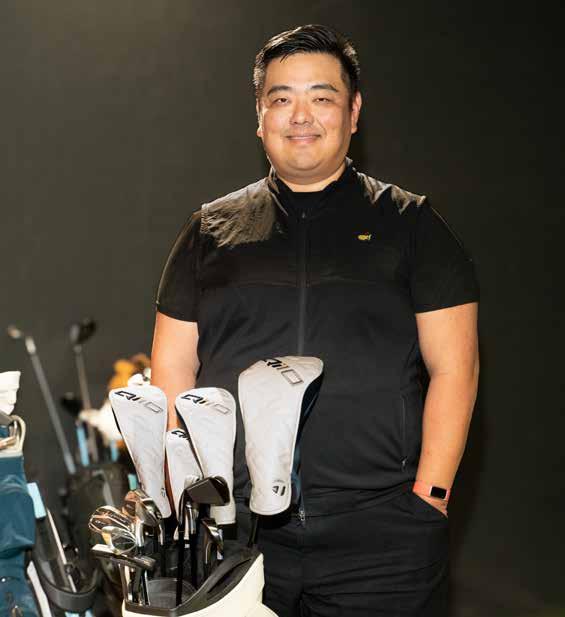
“The TPI assessment is a key component to helping me understand why you can—or can’t—make certain movements in the golf swing,” explains Club golf pro John Kim . “When I initially analyze a golf swing, I use a 2-D video capture and a launch monitor to collect data. This allows me to tailor instruction for more consistent swing mechanics and results. The TPI screening helps me diagnose your movement patterns and describe a certain way to move the golf club to produce more consistent movement patterns and results.
“A player may have had a hip replacement or torn rotator cuff, or just can’t move their body parts like a very elite golfer. The screening tells me why you make certain movements in the golf swing and why you prefer to swing the way you do.
“Launch monitors like TrackMan provide club and ball data, allowing me to assess a golfer’s current swing metrics and monitor their progress over time. If the primary goal is to increase driver distance, we focus on improving club and ball speed—every additional mile per hour of speed can yield approximately 2.7 yards of carry distance.
“If a golfer comes in hitting their driver 220 yards and wants to add 25 more yards, I would work on increasing their clubhead speed from 95 to 100 mph or more and improving the centeredness of contact on the clubface.”
“Having a team at Bellevue Club that speaks the same language across all aspects of golf performance is invaluable,” JJ concludes. “This united front allows for more effective communication between professionals and the golfer, leading to greater understanding and results.”
Jerry has over 30 years of experience developing athletes of all ages for sports performance. He is TPI Level 1 certified and has a bachelor's degree in exercise science and certifications in strength and conditioning (CSCS). He combines his expertise with a focus on increasing functional strength and power, especially in men over 40.
JJ is a Doctor of Physical Therapy and massage therapist, as well as a certified personal trainer and TPI Level 1 certified specialist. With nearly two decades of experience in rehabilitation, performance training and manual therapy, JJ combines clinical expertise with a personalized approach to care. He has worked with professional athletes, providing injury prevention and rehabilitation services.
John is a PGA of America Class A professional and is TPI Level 3 certified. He has spent over 15 years helping players of all ages and abilities learn the game of golf. John has coached players all over the world, working with all skill levels from tour professionals to recreational golfers. He utilizes modern game improvement technology to help players better understand their game and accelerate the learning process.
If you are interested in working with any or all of our TPI-trained professionals, contact their specific department via members.bellevueclub.com
As the seasons change and guests arrive for everything from football watch parties to holiday gatherings, your front entry becomes more than just a door, it’s your home’s handshake. Small changes can create a big impact. Here’s how to instantly elevate your curb appeal this season and boost your comfort along the way.
Your front door sets the tone for your entire home. A beautifully crafted entry door does more than improve aesthetics, it enhances security, seals out the weather, and reflects your personal style. With many colors, finishes, and hardware options to choose from, you can create a look that stands out in all the right ways.
If your back door has seen better days (or you’re still wrestling with a sticky slider), it may be time for an upgrade. A modern patio door can improve energy efficiency, reduce outdoor noise, and create a smoother flow between your indoor and outdoor living spaces.


New This Season:

Explore our collection of storm doors, designed to complement your entryway, provide added protection, and extend the life of your main door.
When it comes to curb appeal, the little things add up. Think bold hardware, elegant glass panels, or a high-contrast frame. Our custom-built doors are made to complement your architecture and elevate your home’s personality! Finish with the Details That Matter 3
Your entryway has the power to transform how your entire home looks and feels. Schedule your free consultation today and explore front doors, patio doors, and our newest storm door styles, designed for beauty, performance, and year-round protection.

written by alison brownrigg





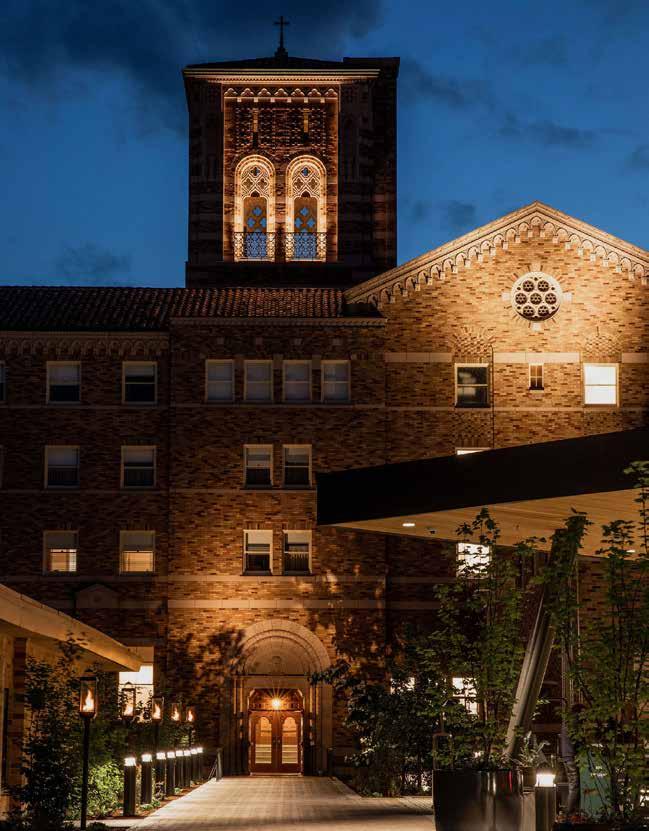
If you haven’t spent much time on the north end of Lake Washington, you might not know about the majestic 326-acre St. Edward State Park.

Located along the border between Kenmore and Kirkland, this serene place has a labyrinth of shady trails, lake access, the largest playground in the entire state and the gorgeous Lodge at St. Edward Park.
The building, designed in Romanesque Revival style by noted architect John Graham Sr. (who is also responsible for the Space Needle), was built in 1931 as a seminary for young men aspiring to the Catholic priesthood. It was used for its original purpose from 1931 to 1976 before the facility and the grounds were sold to the State of Washington in 1977. After 40 years of neglect, the property has been resurrected as a luxe, tranquil getaway just 30 minutes north of Bellevue.


A respectful but cheerful nod to the building’s heritage is apparent throughout, and the interior’s original Art Deco fixtures have been lovingly preserved. Upon entering, visitors are greeted by a long, light-filled hallway lined with art and punctuated by meeting and event spaces that once served as classrooms. It’s a transcendent space on a sunny day.
The former dormitory rooms have been enlarged and appointed with modern, tasteful decor and thoughtful, cozy touches; what once was the dining hall is now a beautiful restaurant called Cedar & Elm that serves innovative and inspired cuisine; and the seminary’s barbershop is the Tonsorium Bar, which houses original relics salvaged from the renovation as well as a mounted trophy unicorn head just for fun.
The property’s spa, Vita Nova, has a menu of all the services one might expect in addition to an infrared sauna, Reiki, energy healing, aura charging and chakra clearing. The latter three especially contribute to the good vibes of the place.

Visitors can reserve time in the newly renovated gymnasium for pickleball on tournament-grade courts. Play is complimentary for hotel guests and requires a small fee for non-guests. Rentable equipment is available on a first-come, first-served basis.
The Lodge at St. Edward is one of only three Washington State hotels awarded a Michelin Key, which, like a Michelin Star for restaurants, implies a high standard of service, interior decor, personality and character. And if it’s one thing the lodge has, it’s character. thelodgeatstedward.com
E X P E R T M E M O R Y C A R E . A L L I N O N E S P E C I A L P L A C E .
MORE THAN A HOME. IT’S A LIFESTYLE.
Licensed nurses and care team 24/7
Chef-prepared meals served all day
Full-service salon and barbershop
Fitness center and saltwater pool
Sky Lounge and private movie theater
On-site physical, occupational, & speech therapy
200+ monthly activities and curated excursions
Housekeeping, laundry & transportation services
Pets always welcome!





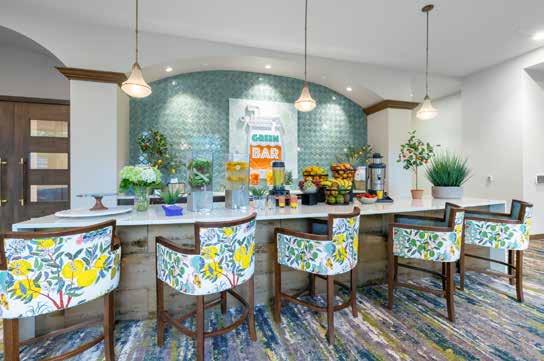




breathwork techniques for mental clarity and stress relief
Breathwork is the conscious control of your breath to influence your physical, mental and emotional states. Unlike many wellness practices that require time, tools or total silence, breathwork offers something else entirely: speed. It’s a direct line to your nervous system—and the effects are backed by real science.
Your breath is the fastest way to change how you feel—because it’s directly wired to your nervous system. Here’s how it works: your autonomic nervous system has two key branches. The sympathetic system revs you up (think: stress, danger, deadlines). The parasympathetic system calms you down (think: digestion, deep rest, recovery). Your breath acts like a remote control between the two.
When you take slow, deep breaths—especially with longer exhales—you stimulate the vagus nerve, which activates your parasympathetic system. This helps lower your heart rate, decrease cortisol, improve digestion and regulate your mood. But you can also breathe in a way that stimulates your sympathetic system to increase alertness, energy and mental clarity. Research shows that breathwork can reduce anxiety, enhance mood and focus, and boost heart rate variability (HRV), a key marker of your body’s ability to adapt to stress, known as resilience.
As a certified breathwork facilitator, I’ve used these tools both personally and professionally. Here are three of the most accessible and effective techniques I use—each one tailored to a different goal.
Best for: focus, anxiety relief, lowering heart rate
Box breathing is a favorite among Navy SEALs and elite athletes. It creates a sense of calm while improving focus and presence.
HOW
• Inhale through your nose for 4 seconds.
• Hold your breath for 4 seconds.
• Exhale through your mouth for 4 seconds.
• Hold again for 4 seconds.
• Repeat for 1–5 minutes.
This method helps regulate oxygen and carbon dioxide levels in the blood, slows your heart rate and balances the nervous system. I recommend using it before big presentations or when you need to mentally reset.
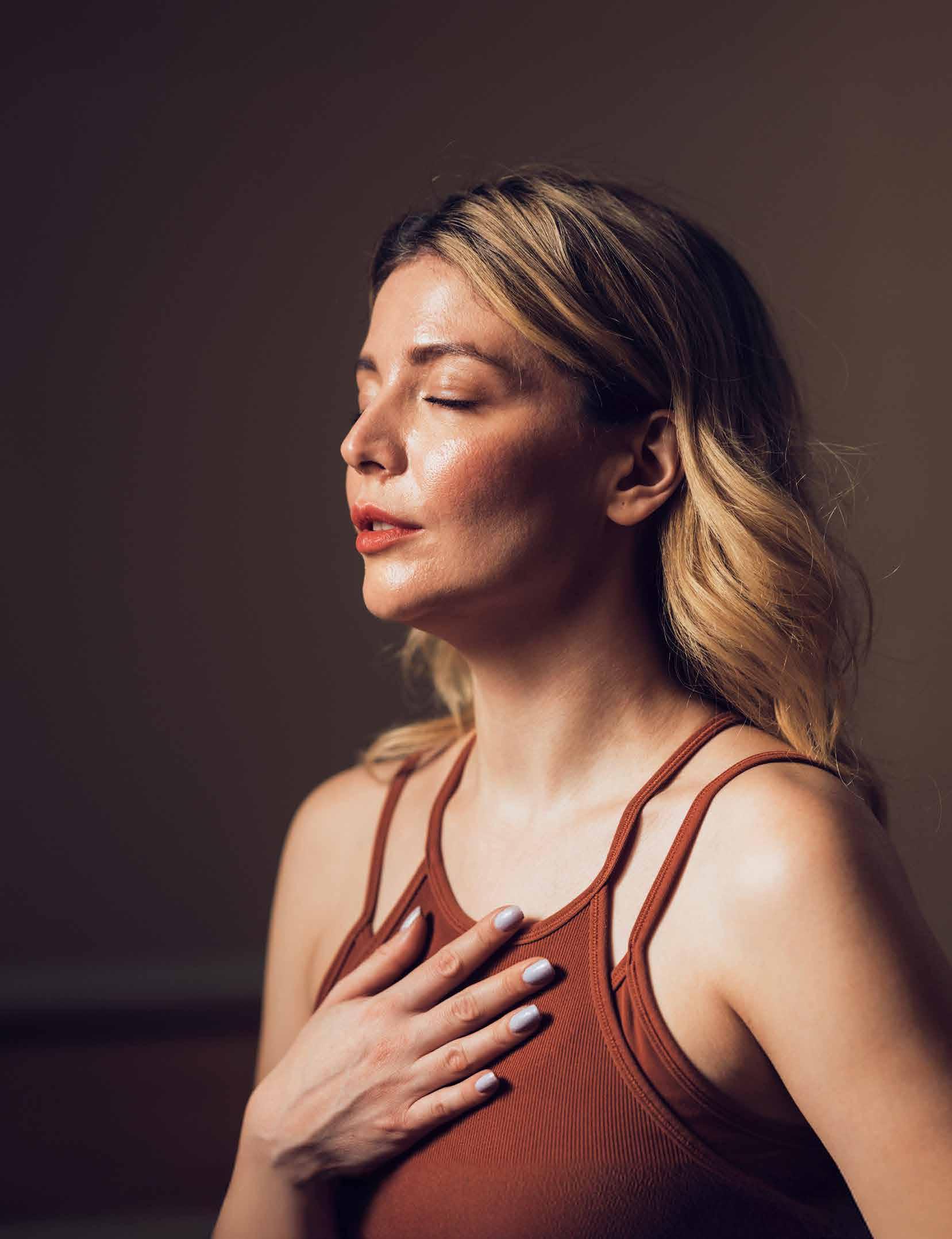


Best for: fast stress relief, nervous system reset
Popularized by Stanford neuroscientist Dr. Andrew Huberman, the physiological sigh is a natural reflex your body already uses (like during crying or yawning) to relieve stress. The deliberate version just makes it more effective.
HOW TO DO IT:
• Inhale through your nose until your lungs are about 80% full.
• Take a second quick inhale through the nose to fully inflate the lungs.
• Exhale slowly and completely through the mouth.
• Repeat 1–3 times.
This double-inhale followed by a long exhale rapidly decreases CO₂ levels in the blood, slows your breathing and instantly activates the parasympathetic system. I recommend this breath anytime you feel a surge of anxiety or tension rising.
Best for: boosting energy, clearing brain fog
Unlike the previous techniques that calm your nervous system, this one gives you a healthy, natural jolt—like an espresso shot without the caffeine. It’s invigorating, energizing and great before workouts or creative work.
HOW TO DO IT:
• Sit tall and make fists with your hands.
• Inhale sharply through the mouth as you raise your arms overhead.
• Exhale through the nose as you forcefully push your arms down.
• Repeat this combo 15 times.
• Rest, then complete 2 more rounds.
This quick, rhythmic breathing stimulates your sympathetic nervous system, improving blood flow and alertness. If you’re hitting a mid-afternoon slump, try this breath.
Isn’t it time to
Your time is money. Why are you still wasting it, stuck in I-5 traffic and Sea-Tac crowds? SeaPort Airlines offers up to 24 flights a day between Seattle’s Boeing Field and PDX. Arrive 20 minutes before your departure. Park for free next to our terminals. Your only regret will be not flying with us sooner.
Book now at flyseaportair.com.

IT’S ABOUT TIME.
written by amylee amos, phd, rdn, ifmcp
REAL TALK FROM AN EXPERT ABOUT A GROWING MEDICAL ISSUE YOU MIGHT NOT HAVE HEARD OF
Metabolic syndrome is a cluster of interrelated conditions that significantly increase the risk of cardiometabolic diseases, which include heart disease and type 2 diabetes. These conditions are abdominal obesity, high blood pressure, elevated blood glucose, high triglycerides and low levels of high-density lipoprotein (HDL or “good”) cholesterol.
Metabolic syndrome is a growing public health concern in the United States, affecting a substantial portion of the adult population. According to the National Institutes of Health, approximately one in three adults in the US meets the criteria for metabolic syndrome.
The diagnosis of metabolic syndrome is established when an individual exhibits at least three of the following FIVE RISK FACTORS:

1. ABDOMINAL OBESITY:
Waist circumference greater or equal to 40 inches in men or 35 inches in women.
2. ELEVATED TRIGLYCERIDES:
Levels at or above 150 mg/dL.
3. REDUCED HDL CHOLESTEROL:
Levels less than 40 mg/dL in men or 50 mg/dL in women.

4. ELEVATED BLOOD PRESSURE:
A systolic reading of greater than or equal to 130 mm Hg or a diastolic reading of greater than or equal to 85 mm Hg, or the use of antihypertensive medication.
5. ELEVATED FASTING GLUCOSE:
Levels greater than or equal to 100 mg/dL, or the use of glucose-lowering medication.
Keep in mind that while an individual needs to exhibit at least three out of the five risk factors to be diagnosed, metabolic dysfunction exists on a spectrum. Having one or two of the risk factors is not necessarily an indication of your metabolic health, but any one of these factors, even in isolation, warrants attention and intervention.
Ectopic fat is the root cause of poor metabolic health. Ectopic fat refers to fat stored in the wrong place, including places like our liver, pancreas and other major organs. Fat can be safely stored in our subcutaneous tissue (the area right under our skin), where it is metabolically safe and does not increase the risk of cardiometabolic disease.
However, everyone has a personal threshold, or ability, to store fat in the subcutaneous tissue. Some people have a greater ability to store more subcutaneous fat than others, due to a combination of genetic and environmental factors.
Once the fat deposition in your subcutaneous tissue has reached its capacity, it begins to be stored elsewhere, in places that do increase your risk of cardiometabolic diseases: in the abdominal cavity, in muscle and within the organs. While measurements such as the body mass index (BMI) and waist circumference are common ways to determine when that threshold has been reached, outliers on both ends of the spectrum exist. That explains how someone who is lean and has a lower body weight might develop type 2 diabetes, while someone with a higher body weight and a greater amount of fat mass may not. Some individuals reach their personal fat threshold quickly, and any subsequent long-term calorie excess results in the deposition of fat in the organs, leading to metabolic syndrome, insulin resistance and eventually cardiometabolic disease.
Fortunately, metabolic syndrome is reversible through diet and lifestyle modification (and, in some cases, pharmaceutical intervention). If weight loss is indicated, slow and steady progress—the result of expending more calories than are taken in—can result in improvement in all the criteria for metabolic syndrome. In addition to weight loss, adopting a predominantly plant-based diet will also improve all aspects of your health.
Choose a diet rich in a wide variety of colorful fruits and vegetables, nuts and seeds, whole grains, plant proteins or other lean proteins and fatty fish to obtain the fiber, phytonutrients and unsaturated fats that support cardiometabolic health. Ideally, including more of these healthy foods will crowd out other foods that have likely contributed to the development of metabolic syndrome, including easy-to-eat processed foods (cookies, chips, baked goods), refined carbohydrates, sugar-sweetened beverages and alcohol. In addition to dietary modification, regular physical activity, aiming for at least 150 minutes of moderate-intensity exercise per week, is also essential.

Early identification and intervention are key to preventing the progression of metabolic syndrome and reducing the risk of associated complications. If you have met some of the criteria for metabolic syndrome, working with a dietitian can help you identify the possible changes in your diet and lifestyle likely to reduce your risk and improve your metabolic health.

Amylee is a registered dietitian and nutritionist. She completed her master of science in nutrition, healthspan, and longevity from the University of Southern California. In addition to her education at USC, Amylee received her PhD from Saybrook University in integrative and functional nutrition and trained with world-renowned biogerontologist and cell biologist Valter Longo, PhD, at the University of Genoa, Italy. She also trained with the distinguished Dale Bredesen, MD, at the Buck Institute for Research on Aging. She completed comprehensive post-graduate training and certification in functional medicine and functional nutrition at the Institute for Functional Medicine. Amylee founded the Amos Institute in 2017, which offers self-paced nutrition courses, provides concierge nutrition services for highly complex cases, and conducts nutrition research. amosinstitute.com


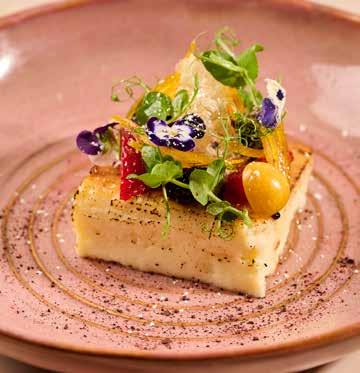

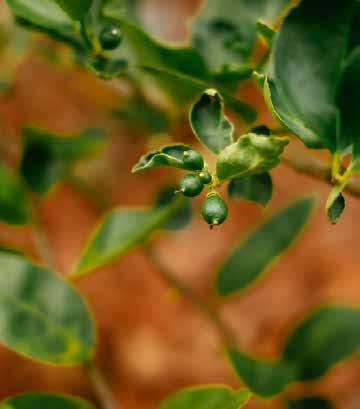
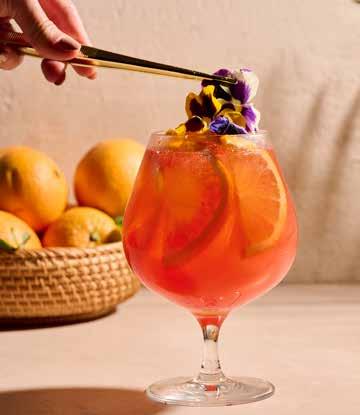

A recent trip to Mexico’s enchanting Yucatán Peninsula was inspired by the sustainability efforts of Chef Richard Sandoval and an invitation to join him and his team on some sweet, beecentric adventures. Using Mérida—a town rich in Mayan and colonial heritage—as home base, we learned about the colorful city as well as Chef Sandoval's mission to leave a legacy that will benefit generations to come.

Ninety percent of Melipona beehives have been lost in the past 35 years due to factors like deforestation and pesticide use.
Dallas-based Richard Sandoval has been building an empire for more than 30 years and is widely considered a global pioneer in contemporary Latin cuisine. His Mexican restaurants span 60 locations across four continents including 10 US states and the District of Columbia.
In 2022, he and his team launched Viva Abejas (vivaabejas.com), an initiative with three mandates: to educate youth on the importance of a sustainable bee population; to support the mission of other, similarly focused organizations, such as the World Bee Project (worldbeeproject.org) ; and to use food and beverages to create awareness among their customers. Chef Sandoval has written a children’s book, also called “Viva Abejas,” with 100 percent of its proceeds benefiting the World Bee Project. This seems especially significant for a restaurant group anchored in Latin cuisine, since bees are major pollinators of avocados and the agave plant.
Mexico is home to the Melipona bee, a stingless species considered sacred by the ancient Mayans. These bees are excellent pollinators who travel up to 1.8 miles to forage. Their flavorful honey is believed to have medicinal superpowers to support the immune system, fight infection and soothe the skin, so these bees are cherished by locals.
Through Viva Abejas, Chef Sandoval helps amplify the key connection between food, the environment and sustainability. In addition to serving bee-centric food and drinks on some of his menus, he’s introduced beehives at several of his restaurants in partnership with Free Range Beehives (freerangebeehives.com), a Denver-based company that is on a mission to support and enhance pollinator populations. So far, they’ve installed 150-plus hives for 35 clients in three US states and Mexico.
Some of our Mérida-area itinerary was connected to sites and people involved in Sandoval’s collaborations. We spent a fascinating morning among the tranquil orange trees of Alma Finca (almafinca.com), a distiller that makes an orange liqueur perfect for margaritas. Free Range Beehives works with them to support pollination, and we saw firsthand how the bright, tropical conditions and rich, coral-enhanced soil make the Yucatán Peninsula the citrus capital of Mexico.
Gathered around small tables in this shaded grove, we savored freshly squeezed juice, fruit, a sweet loaf and numerous samples of heavenly honey straight from the source. We listened to the wisdom of Emmaida Figueroa, owner of Miel Nativa (mielnativa.com), a small business invested in protecting Melipona bees, securing a fair income for local beekeepers and preserving the jungle ecosystem. Emmaida offers educational tours and sells handmade candles and body-care products made from Melipona honey.
With bees on the brain and Mexican flavors on my tongue, I reflected on how much I’d learned in just a few short days—and how I’d love to come back very, very soon.
Intrigued by Mérida? Here are some travel tips.
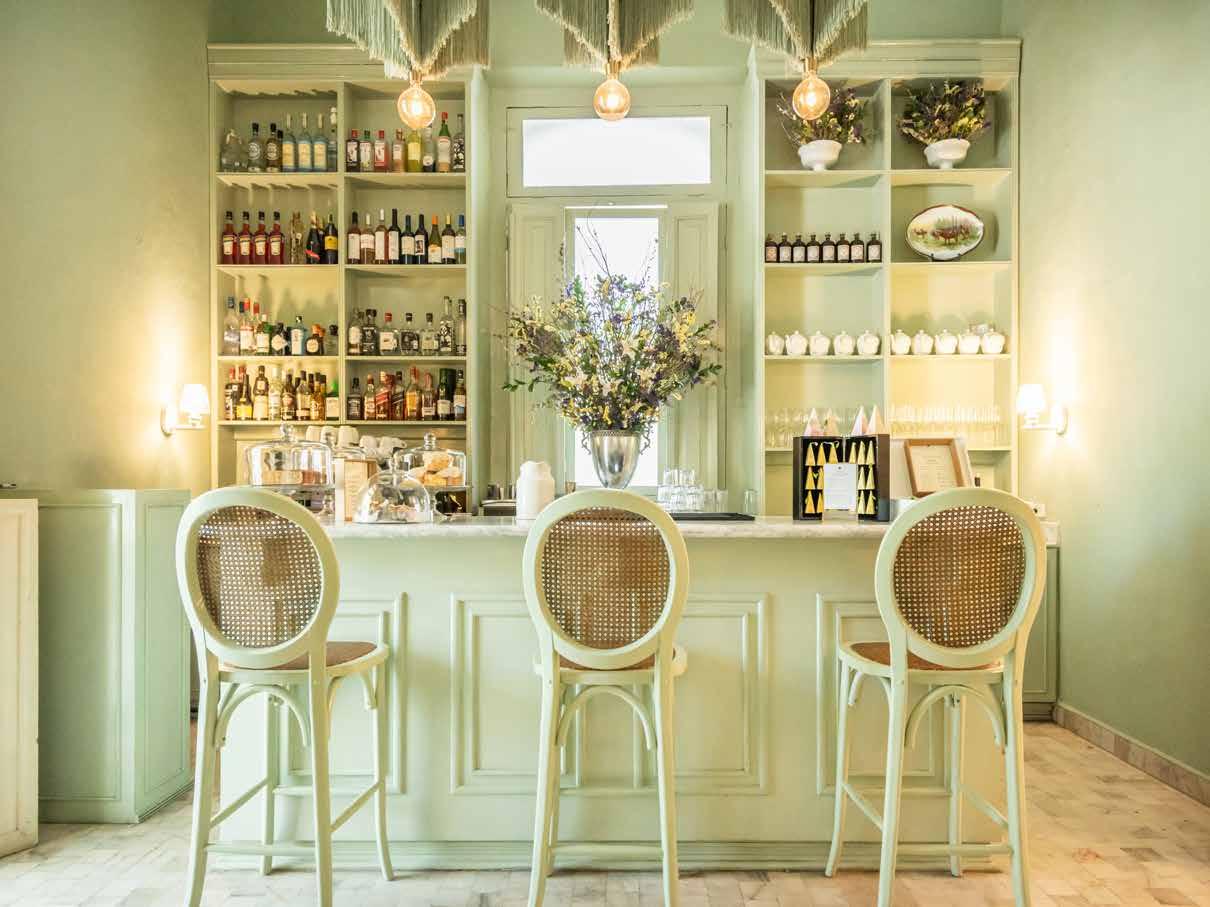


The dazzling beaches of the Yucatán certainly beckon, but this inland gems offer an alternate, jungle perspective, plus access to cultural and culinary offerings away from touristy crowds. We stayed at Fiesta Americana Mérida (fiestamericanatravelty.com), a grand downtown hotel with comfortable beds, a majestic stained glass ceiling above the bustling lobby, and a pool and fitness center. While plenty of dining (and shopping!) options exist on-site, you can easily stroll to nearby businesses, thanks to the hotel’s prime location at the crossroads of the capital’s main avenues, Paseo de Montejo and Colón.
For those seeking a more intimate lodging experience, explore nearby boutique option Adoro Hotel (adorohotel.com). Or if you want to get out of town, consider a glamping adventure on the sprawling and mystical hacienda estate of Hacienda Xtojil (viaturaunseen.com)
Breakfast hours are best spent strolling the majestic, treelined Paseo de Montejo, watching the city swirl to life as vendors set up their wares along stretches of shady sidewalk. To fuel up for the day’s explorations, try Justo Bread Studio (@ justo.bread.studio) or pick up something familiar from the gorgeous Starbucks housed in a mansion with a front patio prime for people-watching.
Standout meals included ceviche blanco, tacos de rib eye and pulpo a la parrilla at Arcano (arcana.rest) ; barbecue at Ánima (@animaaaaaaaaaaaaaaaaa), where the smoked watermelon dish unexpectedly stole the show; and the beef carpaccio and tuna crudo at Ariadna (ariadna.mx), where the brownie finale left a lasting impression.
The magic-tinged ambiance of these airy restaurants marked by overflowing greenery and sultry sounds captivated me. Inside these vibey venues, trees reach upward through open ceilings, as intricate details set the scene, from exquisite tileand-water features to dramatically dripping candelabras.






Be sure to set aside several hours to savor the sheer beauty and tranquility of Casa T’HŌ (casatho.com), a design-fashionart concept house in a rescued and restored abandoned, early 19th-century mansion. Feast your eyes on beautiful architecture and swaying palms, savor a delicious meal in its central courtyard restaurant T’HŌ APERTIVO, and peruse stunning goods found in the 10 boutiques lining its perimeter
Nearby cenotes—natural wells or sinkholes—provide a dreamy swimmable escape, and the region has several sacred Mayan archaeological sites to explore. Cooking classes, like one we took in the small town of Abalá, are another popular option. During an intimate class in a Maya-Yucatec family home, we learned about traditional dishes made using fresh, local ingredients, with techniques passed down from generation to generation. We discovered local products like chaya, a nutritious, leafy green vegetable also known as tree spinach, and helped elders make fresh tortillas over fire before devouring them with our lunch.
On the last day we took a fascinating culinary tour of the city thanks to Eating with Carmen (eatingwithcarmen.com), meeting our affable guide by the large, colorful M-E-R-I-D-A letters in Plaza Grande. He led us through the maze of two buzzing markets, where culinary highlights ranged from gorditas to salbutes and tamales to gigantic juices (mango and coconut horchata being my favorite picks).












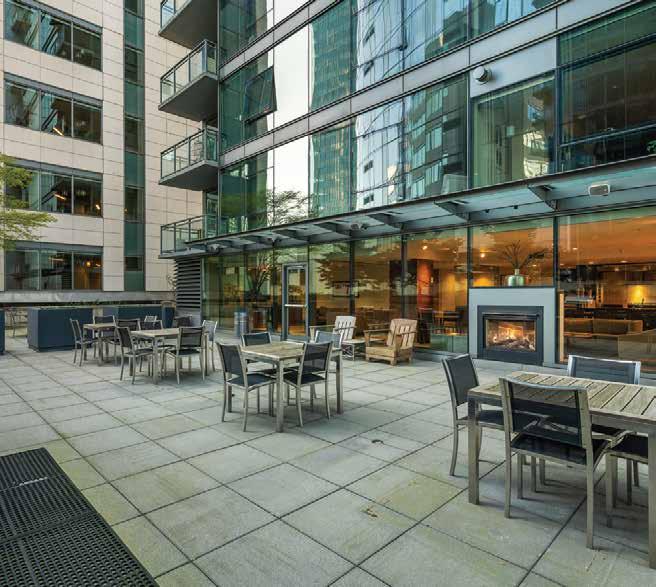

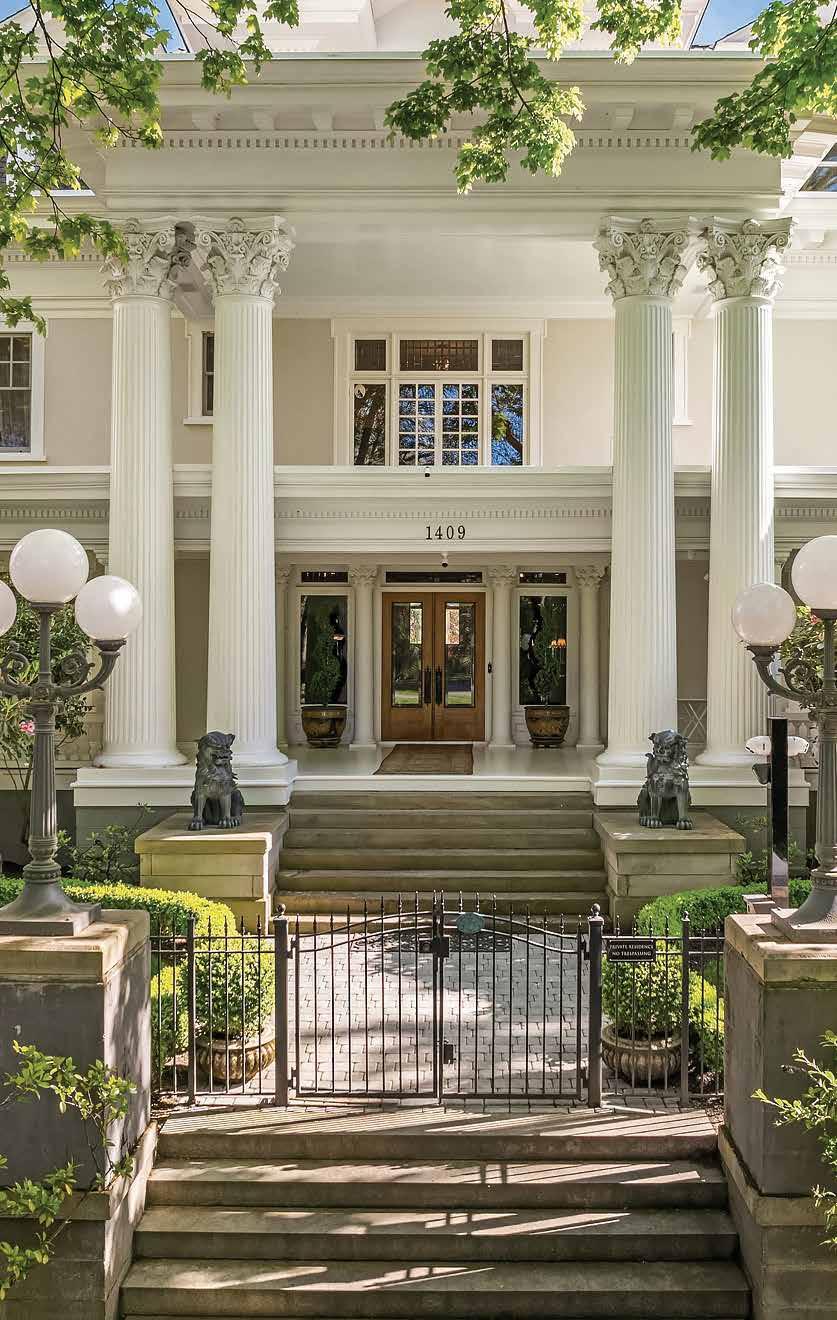










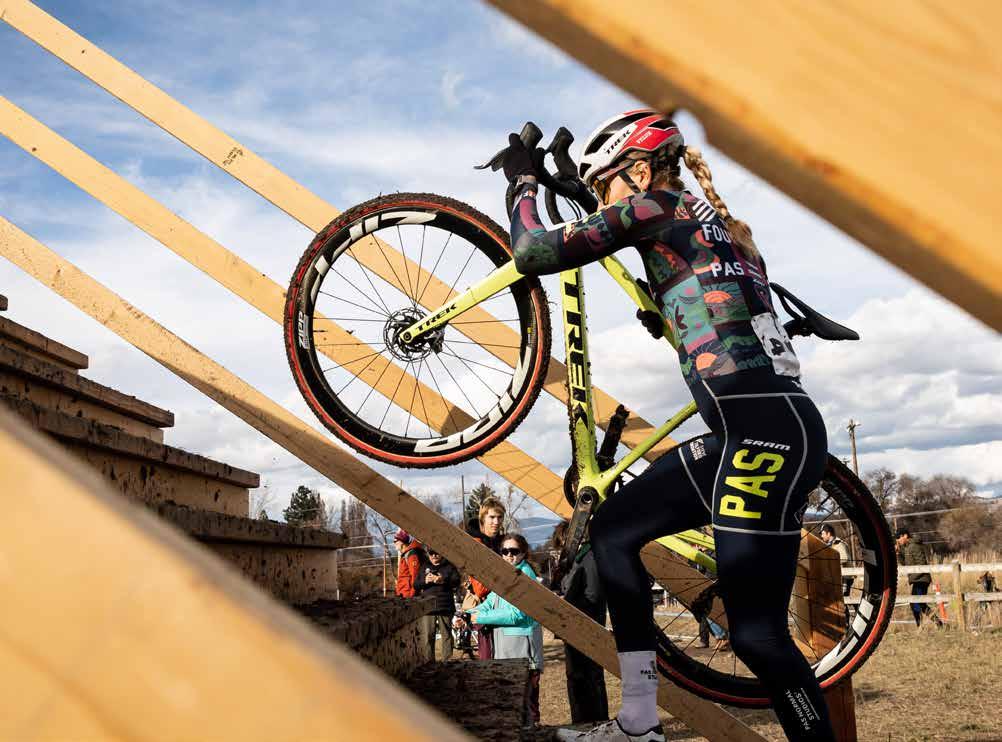
written by alison brownrigg photography by tory hernandez/evrgrn photo
A sport conducted outdoors during fall in the Pacific Northwest can mean only one thing: it will be muddy. Really muddy. And muddy is how cyclocross riders like it.
Cyclocross (CX) is an ultracompetitive and comically unpredictable cycling sport that involves closed-course outdoor races in the fall and winter. While its origins are murky, the most retold version is that in the early years of the 20th century, French army private Daniel Gousseau rode his bike across the ruddy French countryside delivering messages to and from generals. Lore has it that he often had to dismount to conquer the obstacles he encountered on his trips. It was Gousseau who organized the first French CX championship in 1902. In 1910, when Octave Lapize won the Tour de France, he credited off-season CX training for his victory.
Cyclocross was a European sport throughout the 1920s and ’30s, eventually popping up in Chicago in 1963. Now it’s a worldwide phenom, with many organized races and championships regulated by the Union Cycliste Internationale and sanctioned by USA Cycling.
CX courses are one and a half to two miles long, and different every time. Races are composed of four to nine laps, which make it a great spectator sport since riders pass you multiple times in a short period. Participants wind their way through myriad terrains—from dirt to concrete and even over lit firepits on occasion. They slog through sand and confront obstacles and roadblocks that require guts and fast action. Riders are just as likely to slip and slide down a steep hill as they are to face sand pits that threaten to slow them down. Racers must navigate wooden barriers as high as 16 inches by either jumping over them while still on their bike (called bunny hopping) or by dismounting and jumping over them on foot. Bunny hopping is a skill many racers strive to master—for the street cred.
The whole tone of CX is audacious yet convivial, respectful yet irreverent, deliciously unrestrained and always intense. Anywhere from a dozen to a couple hundred cyclists participate depending on how popular the sport is in the region (Portland beats Seattle in terms of its popularity). With that much cacophony, a strong mental game is required and staying calm under pressure is key. Racers can be on and off their bike as many as 30 times in a race that runs 30–60 minutes.
Despite the competitive aspect of CX, the vibe is supportive and the camaraderie strong. Lighthearted hecklers (also known as spectators) cheer and raucously ring cowbells to urge the riders on. Around Halloween many riders show up in costumes, which makes for quite the spectacle. It’s just a whole lot of fun.
The overarching message of CX is that all are welcome, from tender young riders to fierce 80-year-olds. And they mean it too—CX has a very low threshold to entry. Anyone can show up and participate in a race no matter their state of physical fitness or racing experience. If you’re interested in CX, there is a performance category that will fit you. All you need is a bike, the ability to use it, a helmet, some eye protection and a lot of moxie.
Fanatics of the sport report that CX is the hardest yet most fun workout there is. Most, but not all, participants have a moderate to high level of physical fitness and anyone can test ride the course before the race to familiarize themselves with the gauntlet to come. There are free skills clinics at Marymoor Park every Tuesday evening at 6 p.m. through September 16, courtesy of a CX organization called Lemon Peel, to help you bunny hop over the learning curve.

CXR | cross-revolution.com
Lemon Peel | lemonpeelproductions.com
MFG Cyclocross | mfgcyclocross.bike
WA Cyclocross | wacyclocross.org



After a particularly arduous course, one cyclocross fanatic was handed a cup of something she assumed to be water. It was vodka.
Gives a new meaning to “here’s mud in your eye,” doesn’t it?


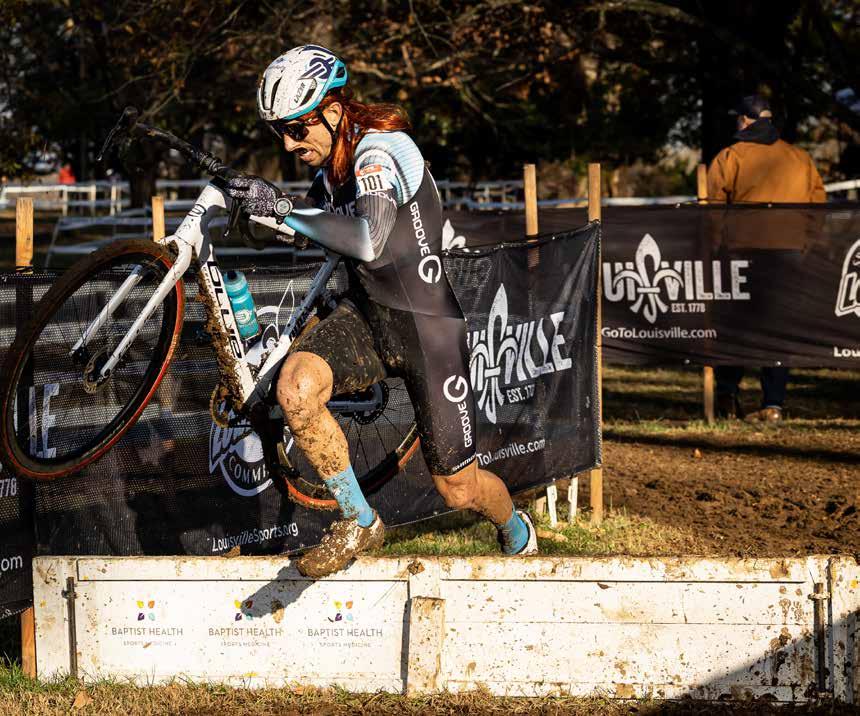
A CX race is an exhilarating, dirty and super-fun experience. You will most likely be wet, cold and tired at the end, but you’ll also be grinning ear to ear and leaving with some new like-minded friends.
To be clear, you don’t need a special style of bike for CX. Some people show up on mountain bikes and others on gravel bikes. However, a specific CX bike (CXB) has evolved over the years to accommodate the beating they take on the course.
• Originating from a road bike, CXBs have a slightly different frame anatomy and are lightweight yet stiff and responsive, usually made of aluminum or carbon fiber.
• Their frames are wider and house narrow, knobby tires, meant to handle what the course throws at them: copious amounts of mud.
• Tires are generally at a lower pressure to increase traction. Because, mud.
• The gears are also kept lower to account for the hills and mud.
• Participants often run with their bikes hiked up over their shoulders, so top tubes are shaped for easier shouldering, with flattened undersides for comfort. That doesn’t mean you won’t get a wicked bruise there. But again: street cred.
• Bottom brackets are higher to avoid drag (from the mud) and for obstacle clearance.
• Disc brakes are almost exclusively used for more control in the mud.


The Mid-Autumn Festival blends ancient folklore and modern family traditions in one of East Asia’s most cherished holidays.
written by alison brownrigg

Every year on the 15th day of the eighth month of the Chinese lunar calendar, when the moon is at its fullest, East and Southeast Asian communities around the world celebrate the Mid-Autumn Festival. Families gather on this night to give thanks, eat mooncakes, light lanterns and gaze at the moon.
This family-oriented festival, which corresponds to September or October in the Georgian calendar, has its roots in ancient moon worship and harvest celebrations, though the festival became widely celebrated during the Tang dynasty (7th–10th centuries CE). Its origins can be found in the story of the moon goddess, Chang’e, and her companion, the jade rabbit, Yu Tu.
Like most folklore, this story has many versions, but most revolve around Chang’e’s husband, the archer Hou Yi, who shot down nine of the 10 suns in the sky that were scorching the earth. As a reward for saving humanity, Hou Yi was given one dose of an elixir of immortality, but he didn’t want to become immortal without Chang’e, so he gave it to her for safekeeping.
One day, in mid-autumn, a jealous apprentice of Hou Yi tried to steal the elixir away from Chang’e, who consumed it rather than hand it over to the would-be thief. As she swallowed it, Chang’e became lighter than air and floated to the moon, where she now lives with Yu Tu.
Heartbroken, Hou Yi began offering sacrifices of her favorite foods every year on the 15th day of the eighth month. Eventually, the people followed suit out of sympathy for the great hero and in deference to the moon goddess herself.
One of the quintessential hallmarks of the Mid-Autumn Festival is the sharing and eating of mooncakes. These round Chinese pastries are filled with dense lotus seed or red bean paste, nuts, and sometimes a whole salted egg yolk to represent the full moon. Every region has its own way of making mooncakes, but it’s the Cantonese style, with their lovely light brown pastry crusts that are most recognizable at Asian grocery stores and bakeries around the world. Traditionally, each mooncake is stamped with an imprint of the Chinese characters for longevity or harmony, the filling type and the name of the bakery.
In some myths, mooncakes were a special favorite of Chang’e, but in other legends, mooncakes were used by peasants to send secret messages of rebellious uprising against the Mongols on the 15th day of the eighth month during the Yuan dynasty (1279–1368 AD).
In Taiwan, grilled meats, fish and vegetables are a mainstay on the Mid-Autumn Festival menu. Families set up small outdoor barbecues and grill under the light of the full moon. Pomelos are another traditional festival food in Taiwan, and you’ll often see children wearing cute hats made from the peel of this round, moon-shaped citrus fruit.
In Korea, where the festival is called Chuseok, families make and eat songpyeon, half-moon-shaped rice cakes filled with sesame seeds, red bean or chestnut paste and steamed over a bed of pine needles.




In Vietnam, this festival is considered “children’s day” and is feted by paper lantern and lion dance parades, adding to the revelrous atmosphere of the occasion. Round lanterns, reminiscent of the full moon, symbolize the happy togetherness of family life. These lanterns sometimes come with riddles, written on little tags, that partygoers try to answer together. The riddles, popular since the 13th century, often involve wordplay and jokes about current events and are meant to create a lighthearted mood among the crowd. These days, most people would call them “dad jokes” when written in English; however, when written in Chinese, they’re often more difficult to solve due to the language’s many homophones and nuanced characters. Here are a few of our favorites in English and Chinese. Test your wit and see how you do!
1. I’m tall when I’m young, and short when I’m old. What am I?
2. What has keys but can’t open locks?
3. The more you take from me, the bigger I get. What am I?
灯谜
1. 谜语: 「一点一横长,一撇到南洋,南洋有个人,只有一寸长。」
2. 谜语: 「中秋佳节话团圆」
3. 谜语: 「身穿银甲水中游,一生只往前不回头。」
See page 64 for answers.

In the weeks leading up to the MidAutumn Festival, Asian grocery stores and bakeries are brimming with mooncakes traditionally shared as gifts among friends and family. In recent years, luxury brands like Gucci, Saint Laurent, Chanel and Louis Vuitton have embraced the tradition, releasing exclusive gifts for their very important clients (VICs) as a gesture of appreciation.
While we may not all be VICs, we can still enjoy a touch of luxury. Each year, boutique bakery and confectionary Lady M—conveniently located at Bellevue Square—releases a highly anticipated, limited-edition gift. For 2025, it’s the Jade Rabbit Lantern Gift Set, a gorgeous, illuminated lantern that spins to reveal the jade rabbit’s sojourn from the forest to the moon palace.
Tucked inside are six handcrafted mooncakes in three flavors—Strawberry Matcha, Coconut and Tiramisu— made in collaboration with the iconic Kee Wah Bakery. This enchanting gift is available in store starting September 8. →ladym.com

5



3


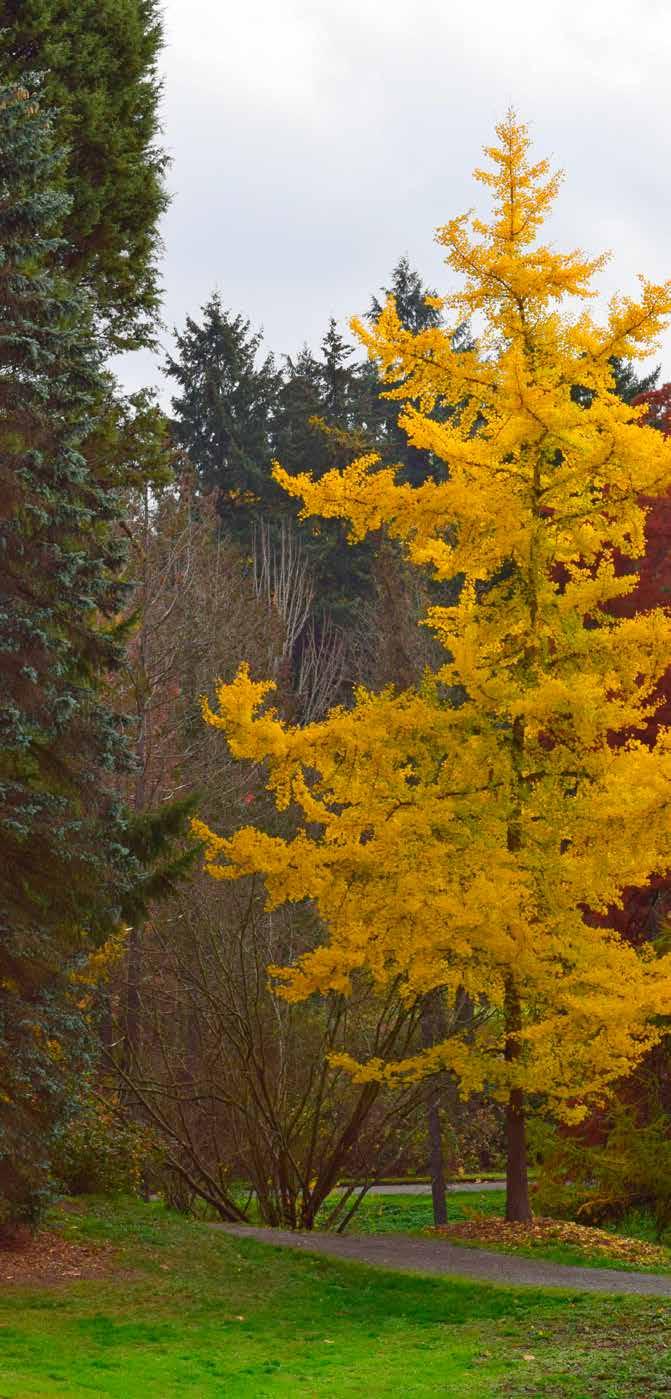

HOW ONE MAN IS RESHAPING THE WAY THE
For generations, conservationists have worked to protect natural places and the life within them—efforts that continue to evolve in response to the challenges of a modern world.
At the forefront of this movement is Bellevue Club member Peter Seligmann, a conservationist whose influence spans continents, communities and decades. His work has helped reshape how the world values nature— not just as a resource but as an investable asset for our shared future.
Peter is, among many things, the cofounder of Conservation International (CI), a nonprofit focused on the link between human wellbeing and the natural world through scientific and policy partnerships with governments, businesses and communities worldwide.
As CEO of CI from 1987 to 2017, Peter helped protect over 2.3 million square miles of land and water across more than 70 countries.
A trip to the American West left a lasting impression on a young Peter. “When I was 13 years old, I worked on a ranch in Wyoming,” he recalls. “My job was to irrigate the pastures. As I waited for water to flow across the fields, I watched bumblebees select which stalks of grass to gather pollen from.”
It was then that he realized the bees were making choices—and those choices influenced the environment. He also recognized that human well-being is closely connected to the natural world and the systems that sustain it.
While at CI, Peter forged partnerships with major global corporations, including Starbucks and Walmart. The goal was to build a bridge between conservation and business, demonstrating that the two are not mutually exclusive.
The collaborations acknowledged that these big corporate players rely on natural resources (coffee, beef, seafood) for their business and that improving the environmental impact of their supply chains could protect and improve their bottom line. He worked with companies to explore how supporting conservation efforts could help reduce future risks and improve supply chain resilience— benefiting both the environment and their business operations.

Peter is also credited with playing a key role in the first-ever debt-for-nature swap—a landmark model linking debt relief with environmental protection. In 1987, as he was paddling down a river in the Amazon, he picked up a wet newspaper and read that the president of Peru had declared that his country would not pay the debts it owed to foreign banks. “As the value of this debt decreased, it could be bought for pennies on the dollar,” says Peter. “I had the idea that we [CI] should buy the debt and offer to forgive it in exchange for the protection of large conservation areas. We did the first debt-fornature swap in 1987 with the government of Bolivia and created the Beni Biosphere Reserve. Many more followed.”
After stepping down as CEO of CI in 2017, Peter cofounded Nia Tero, a global NGO based in Seattle, committed to supporting the rights that Indigenous people around the world have, to protect their native environment. “At CI I was exposed to Indigenous leaders and their concerns that conservation programs had displaced people from their homelands,” he says. “What I realized,” he continues, “was that Indigenous people safeguard close to one-third of the earth and that their territories contain at least 40% of global biodiversity and 25% of stored carbon.” To date, Nia Tero has partnered with more than 300 Indigenous communities that are stewards of more than 300 million acres across the world.
It is carbon that is the crux of Peter’s most recent undertaking as chairman of the board of Silvania, a natural capital investment fund that helps governments and landowners generate carbon credits through large-scale forest restoration and conservation.
On a recent walk through the Arboretum, Peter explained to me that the goal is to monetize what nature provides and to help private capital support large-scale restoration. In his view, philanthropy and public funding are essential but insufficient. “Silvania is a fund created to establish that nature is an investable asset class,” he explains.
Is valuing nature as a commodity the only key to ensuring that the planet remains habitable for all beings? No, says Peter, “the key word is reciprocity. We are related to nature and need to see the natural world as a relative rather than simply a resource.”
Population growth and consumption have had “radical unanticipated impacts on the stability of ecological systems and their ability to support life,” Peter explains. This threatens weather patterns, food security, clean water and breathable air worldwide. “The simple truth is that we depend upon nature to make this planet healthy.”
When asked to reflect on his impact and what he hopes his work has made possible for future generations, Peter answered, “a recognition that innovations are essential. That doing what we have done in the past is insufficient, and we must look for new approaches and think long-term because the future always arrives.”

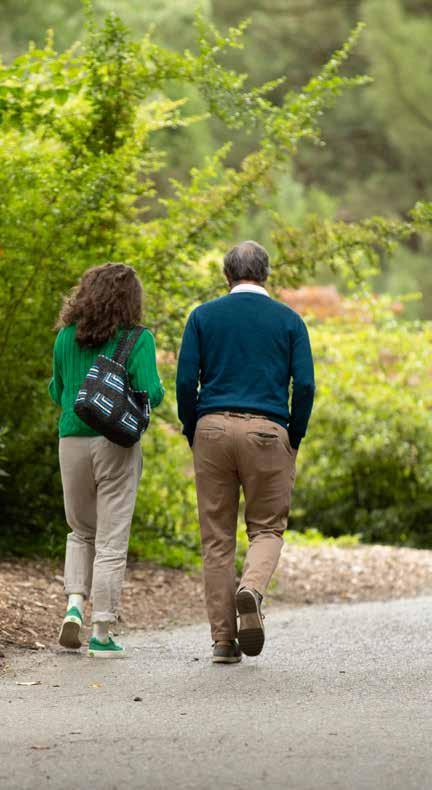




Peter has a long list of accolades: he was named one of Time magazine’s 100 Most Influential People and he is a member of the Council on Foreign Relations. He is recognized as one of Yale’s most influential graduates and is a frequent speaker at the World Economic Forum in Davos, Switzerland.
In person, Peter is friendly, charming and utterly self-effacing. He is married to Lee Rhodes, founder of Seattle-based glassybaby, which has donated more than $15 million to various charities. If you’re unfamiliar, glassybaby is a line of glass votive candle holders available in over 500 colors that shot to fame after Martha Stewart hosted Lee on her show in 2005. When asked which color is his favorite, Peter diplomatically answered, “All of them.”
Between them, Peter and Lee have six adult children and a growing gaggle of grandchildren. At 74, Peter spends as much time as he can at his ranch in Montana, where he works to protect the local wildlife, grow food, and study soil and forest restoration in between visits from his kids and grandkids.
Give your child an educational experience that will open doors.
Innovative curriculum built on facilitating second-language learning
Professional early childhood educators
State-of-the-art campuses designed to enhance the learning experience
Safe outdoor areas for active play and learning
*Language programs and ages vary by location














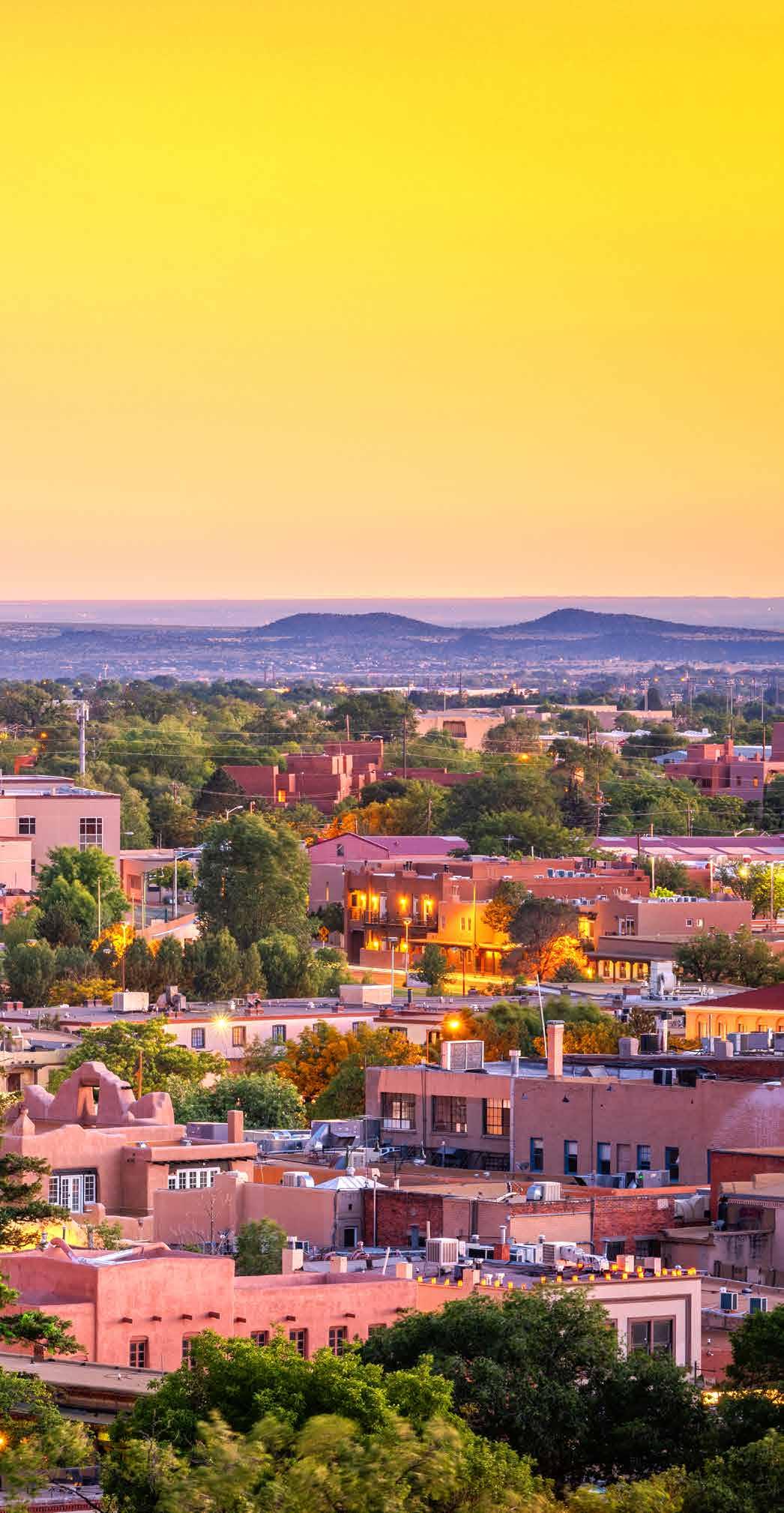
SANTA FE IS A CITY BORN OF A VIBRANT AND COMPLEX INTERPLAY BETWEEN NATIVE AMERICAN, MEXICAN AND SPANISH CULTURAL INFLUENCES, WHICH MAKES IT HARD TO DEFINE AND TOTALLY UNIQUE.
Founded in 1610 by Spain, Santa Fe is the oldest capital city in the United States, beating the founding of the Mayflower Pilgrims’ Plymouth Colony by 10 years. There is archaeological evidence of a well-established Pueblo Bonito village at Chaco Canyon by 1050, and since 1692 control of the city has bounced between Spain, Mexico and, finally, the United States. Statehood came relatively late—in 1912, when the city was just over 300 years old.
While there’s something to love about New Mexico all year round, fall is Santa Fe’s season. At 7,300 feet above sea level, mountain nights bring a chill countered by the satisfying and singular smell of piñon wood burning in adobe fireplaces. Warm days come with the sun, its brightness mirrored by golden aspens glowing on the Sangre de Cristo Mountains. It’s a magical time in the Land of Enchantment.
written by zibby wilder
If Santa Fe is the City Different, the Inn of the Five Graces is the Hotel Different. This captivating boutique hotel, in Barrio de Analco, the oldest residential neighborhood in the United States, is decadently designed in Afghan- and Tibetan-inspired style by the owners of the local import shop Seret & Sons. Once inside the iconic adobe walls of this once-neglected cluster of buildings, guests are treated to a gorgeous cacophony of vibrant tiles, fabrics, colors and patterns that feels like a land all its own. fivegraces.com
Hotel St. Francis is the oldest of Santa Fe’s historic hotels. Because of its age, the rooms are a bit smaller than more modern offerings, but one can really feel the history here. Collected Works, a favorite local bookstore, is just around the corner, and next door is the Gruet tasting room. The Wine Spectator has named Gruet’s sparkling wines among the “Top 100 Wines of the World,” yet most people are surprised to learn Gruet is a New Mexican winery. In fact, New Mexico’s first vines were established in 1629, about 196 years before Washington’s. hotelstfrancis.com
Just a few miles outside Santa Fe, near the scenic village of Tesuque, the Four Seasons Resort Rancho Encantado caters to adventure seekers. Guests can join hikes or ride bikes on local trails, or book personalized excursions to nearby attractions including cliff dwellings or Georgia O’Keeffe’s studio in Abiquiu. And if the weather’s right, you can play in the powder of Ski Santa Fe. fourseasons.com/santafe

Though many people know Georgia O’Keeffe for her flowers, she was called the “Mother of American Modernism” for a reason. The museum crafts thought-provoking shows and programs that go beyond flowers—exploring the artist, her inspirations and those she has inspired. okeeffemuseum.org

A free transit shuttle runs year-round to carry visitors from downtown to Museum Hill, just a few minutes away. A cluster of museums here is anchored by the Museum of International Folk Art, born of the collection of famed designer Alexander Girard. museumfoundation.org
This train is credited with turning Santa Fe into the modern city it is today. At the beginning of the 19th century, the Santa Fe Southern ferried tourists and transplants into town, from presidents and movie stars to academics and artists. Thanks to local businesspeople, including Game of Thrones author, George R. R. Martin, the historic line and its restored train cars (plus an amazing, open-air flatbed car) are back in service for sunset and scenic rides. skyrailway.com
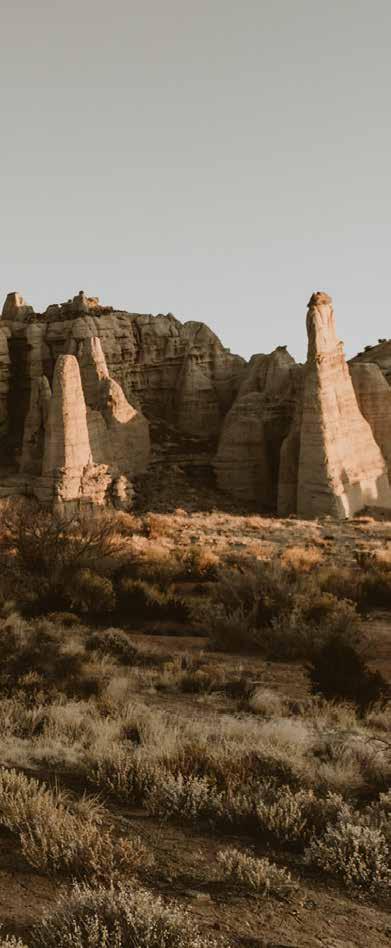


The Railyard, which surrounds Santa Fe’s still-operating train depot, has a diverse set of offerings for all travelers. It's the site of the Santa Fe Farmers’ Market which, during fall, runs Tuesdays and Saturdays from 8 a.m. to 1 p.m. Unlike many farmers’ markets, all produce sold is certified locally grown in northern New Mexico. Also on offer are delicious baked goods and other treats like tamales and fry bread. If it’s not a market day, grab some New Mexican comida at Tomasita’s or a seasonally flavored scoop at craft ice creamery, La Lecheria. railyardsantafe.com
In 1953, the Carswell family discovered the recipe for success when they opened the Shed just off downtown Santa Fe’s historic plaza. A beloved source for delicious chile, it quickly became so popular, a sister restaurant, La Choza, was opened. La Choza is where you’ll find locals trading stories at the bar while enjoying a cold beer and some hot chile. Try the green chile clam chowder, pozole and adovada, but whatever you choose, do NOT miss out on La Choza’s steaming hot sopaipillas. lachozasf.com
Legendary local culinary star David Sellars opened his bistro after a decade spent running the Street Food Institute, a nonprofit he founded to teach people the food truck biz. Horno (the Spanish word for outdoor adobe ovens used by Native Americans) bills itself as “a gastropub where street food meets indoor dining.” It has quickly become a local favorite thanks to quality service and a diverse menu offering creative dishes ranging from dumplings and focaccia to Sellars’s award-winning burger. hornorestaurant.com


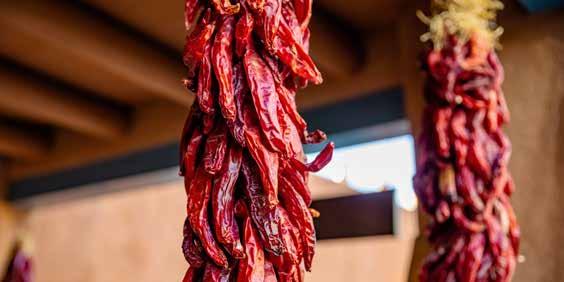
Life in New Mexico—not merely the cuisine—revolves around chile. Though the state is most famous for chile grown in the Hatch Valley, you can’t go wrong with those from other locales such as Socorro or Chimayo. The heat varies from mild to extra hot, and everyone has an opinion on which farm produces the best crop.
In the fall you’re likely to spy bushels of green chile being roasted in big spinning barrels at farmers’ markets, grocery stores and roadside stands. Red chile, found as dried pods or powder, is ripened green chile and the key component of the ubiquitous ristras seen hanging in the sun.
Order almost anything at most restaurants (even fast-food chains) and you’ll have the choice of red or green chile sauce drizzled over it or stuffed in it. Red has a lovely spicy/sweet flavor, whereas green has a verdant taste with a touch of smokiness from the roasting process. Until you’re sure which one you like better, order “Christmas” to get a little of both and your server won’t even blink an eye.
Even the most experienced international shopper will appreciate this 40-yearold boutique on the edge of Santa Fe’s central plaza. As a showcase for global fashion, Santa Fe Dry Goods curates fine clothing from modern designers inspired by authenticity, innovation and timeless beauty. santafedrygoods.com
A gallery, shop and museum, Shiprock focuses on the best of vintage and modern Navajo blankets, Native American jewelry and Pueblo pottery, coupled with a mid-century modern aesthetic. It is one of Santa Fe’s most original shopping experiences and a must-visit for anyone interested in historic and contemporary Navajo art. shiprocksantafe.com
Canyon Road is popular for its art, but its shopping is just as stellar. Do not pass by Cielo Handcrafted, a family-run cooperative of crafts, clothing and jewelry by local makers including the talented Gloria Olazabal. If you’d like to add a little Santa Fe to your aesthetic, visit Homefrocks, where owner and designer Nancy Traugott creates dreamy, organic threads of botanically dyed linens and velvets. visitcanyonroad.com

It’s hard to describe Ten Thousand Waves. It’s a spa with massage and other services, soaking pools, a restaurant and some very special lodging options. It’s also likely the most authentic Japanese spa experience outside of Japan. It's located a short ten-minute drive from downtown Santa Fe, but you’ll swear you’re in the mountains of Japan. tenthousandwaves.com
The “original” Ojo is a scenic one-hour drive north of Santa Fe. The thermal springs that feed the various pools here range in mineral content and temperature and were once sacred places for local Native Americans. These days, Ojo Caliente is more of a day-visit for travelers looking for a refresh, but for those looking for a longer respite, the Posi and Cliffside suites offer private pools for the ultimate relaxation.
More retreat than spa, in-town Ojo Santa Fe offers fine baths for soaking but is centered more on adventure and play than many spas. Lodging guests can take part in activities ranging from archery and ceramics to yoga and hiking—there’s even a puppy pen where you can cuddle with pups from the local shelter as they await their furever homes. ojosparesorts.com


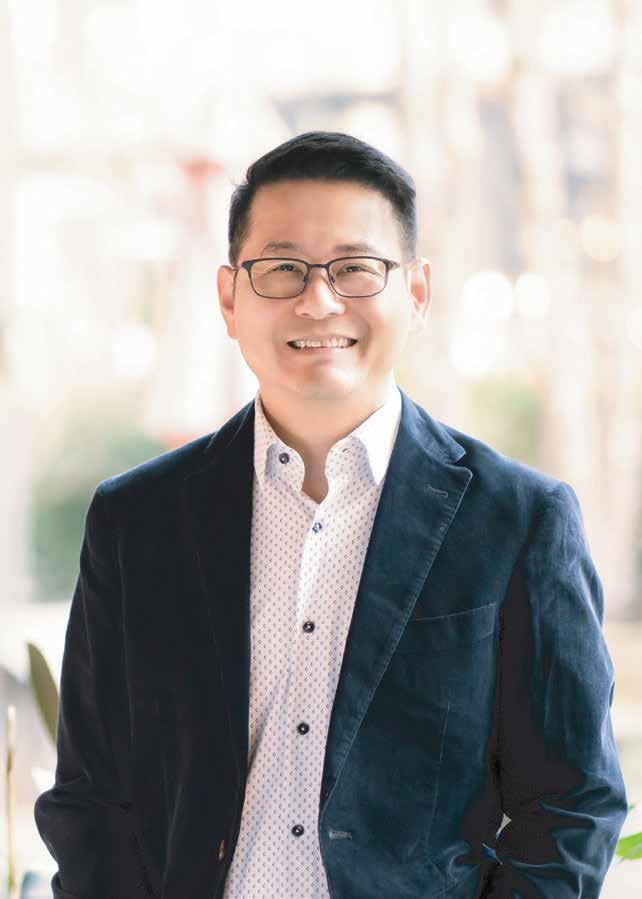
• Trusted by 500+ families to achieve their homeownership and investment goals.
• Expert in lifestyle upgrades and smart investments.
• Personalized, resultsdriven guidance every step of the way. As someone deeply rooted



Bellevue Club played host to the 21st annual mixed doubles tennis tournament in late June. Nearly 250 players participated in the tournament and attended the player party and auction. In the last 20 years this event has raised over $600,000 for local charities.


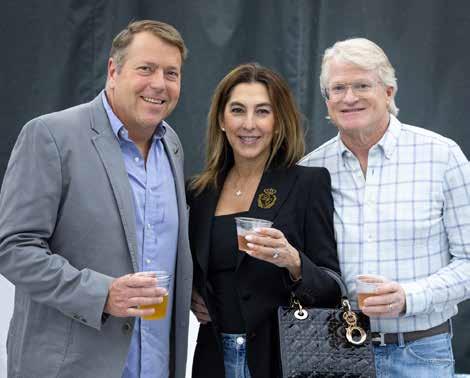





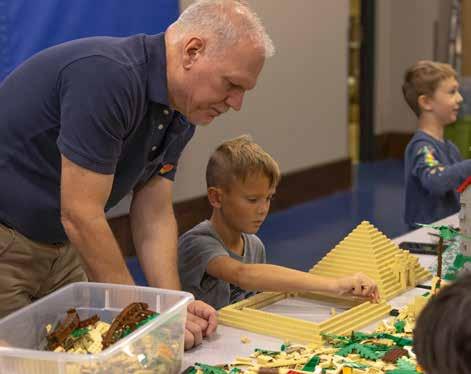

Here's a huge shout-out to our dedicated team of camp counselors who helped make this summer fun for our junior members. From golf lessons at the Links to craft time with princesses, our camps were a huge success, thanks to the energy and enthusiasm of our incredible staff. See you next summer for more good times and new memories.



ANSWERS FOR RIDDLES ON PAGE 48
1.A candle. Explanation: A candle gets shorter as it burns.
2. A piano. Explanation: “Keys” here refer to piano keys, not physical ones. 3.A hole. Explanation: The more you dig, the larger a hole becomes.
1.谜底:府 解释: 这是对“府”字结构的幽默描绘,结合了汉字笔画的形象。
2.谜底:月 解释: 中秋节象征团圆,月圆代表家庭的完整。
3.谜底:鱼 解释: 描述鱼的外形和特性:银色鳞片、生活在水中、游动时不回头。


There are no greater rivalries than those in sports. The Sonics (RIP) once had the Trail Blazers, the Seahawks have the 49ers and the Huskies have the Cougars. Or the Cougars have the Huskies—depending on your allegiance.
Washington’s collegiate cross-state competition started, football-wise anyway, in 1900 when Washington State University was known as the Agricultural College, Experiment Station and School of Science of the State of Washington.
It wasn’t called the Apple Cup then—that name didn’t appear until 1962, when the state’s Apple Commission realized the event was a stellar marketing opportunity. Apart from an interruption by the pandemic in 2020, the two have faced each other at least annually, usually late November and usually at alternating home stadiums.
The Apple Cup provides a lot of entertaining trash talk, schadenfreude and school pride for both teams each year. While the Huskies have won the lion’s (or should I say dog’s) share of the games, each school proudly displays the trophy when it wins, good-naturedly razzing the year’s loser as dust gathers on their empty shelf.
Things changed in 2024 when the Huskies left the Pac-12 (along with most of its other teams) for the greener Astroturf of the Big Ten, ending the quest for conference supremacy and dulling the rivalrous polish on the Apple Cup. The game has moved from its traditional late November slot to an earlier date—it’s September 20 in Pullman this year.
The teams have agreed to keep the competition alive and the trophy in play until 2028 at least. After that, the Apple Cup’s fate is unknown, but what is certain is that the Huskies will still have more wins and the Cougars will still have their canned cheese.
Written with a wink by:
Alison Brownrigg, University of Washington, Class of 1995
APPLE CUP WATCH PARTY
COSMOS + ATRIUM | 4-9 PM
We’re going all out with school-themed drinks and tailgate-inspired bites for this party, so wear your school colors and bring your crew to watch the ultimate showdown here at the Club.
photo
september 20 • WATCH PARTY 4-9 PM


Now open on Main Street in Bellevue, Lévy Aesthetics is redefining beauty and longevity. Introducing Club Lévy, membership programs that pair advanced diagnostics with premium aesthetics treatments. Curated by award-winning physicians Dr. Daniel Lévy and Dr. Joe Upton, each tier blends science-backed wellness with premium aesthetic treatments, delivering exceptional value, personalized care, and visible transformation.
BE AMONG THE FIRST 50 TO ENROLL IN OUR LA SIGNATURE MEMBERSHIP AND RECEIVE AN EXCLUSIVE BELLEVUE CLUB EXPERIENCE —ON US.
Signature LA Signature
ENJOY 2 NIGHTS AT THE BELLEVUE CLUB HOTEL AND A $1,000 BELLEVUE CLUB GIFT CARD. LIMITED TO THE FIRST 50 ENROLLEES. OUR MOST ELITE, CONCIERGE-LEVEL
$999/month, $4000 in yearly savings
BE ONE OF THE FIRST 50










